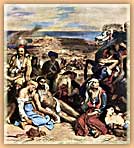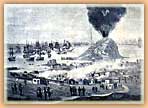 |

During the Revolution the Ottoman navy was employed mainly as a subsidiary force in the expeditions conducted in the Peloponnese and Rumeli. The transportation of troops, the provision of Ottoman forts and the naval blockade of the besieged were its main aims and uses. This operational tactic indicates that the repression of the uprising on land was a priority for the Ottoman Empire.
The Aegean Islands were not a defined target. The operations against Samos (1821 and 1824), which were repelled by the Greek forces, as well as the occupation of Chios in 1822 and of Kasos and Psara later in 1824, resulted in extensive massacres, plundering and destruction on these islands.
Despite the active support of distinguished individuals from Chios, men such as Theophilos Kairis, in advancing the Revolution on their island in the spring of 1821, this was not possible. The following year they turned to Samos and approached Lykourgos Logothetis for help. Indeed, in March 1822 a common expeditionary force was organized; it conquered Chios unexpectedly, obliging the Ottoman forces on the island to seek refuge in the fort. At the same time the Ottoman fleet sailed out of the Dardanelle straits and began the attack on Chios.
In March thirty thousand Ottoman troops landed unobstructed on the island - on which the Greeks had taken no defensive measures.
Some ships from Psara, which were already in the region, followed from a distance the moves of the Ottoman fleet. The terrified inhabitants abandoned the town and sought refuge in mountainous areas and monasteries while the Samiotes rushed back to their island. In the days that followed a generalized massacre, acts of plunder and destruction took place.
Of the one hundred inhabitants of Chios at that time, one-third was massacred or captured while other Chiotes escaped with ships to Syros, Psara, the Peloponnese and elsewhere. The violence of the admiral of the Ottoman fleet (kapudan pasha) Kara Ali - who was killed a few days later when Konstantinos Kanaris blew up the flagship of the Ottoman fleet off Chios - horrified the Europeans and gave a new impetus to the philhellenic movement which had flagged after the massacre of the Muslims of Tripolitza in September 1821.
More than two years after the destruction of Chios, at the end of May 1824, the Egyptian fleet landed unimpeded thousands of soldiers on Kasos, soldiers who had successfully destroyed the last revolutionary centres in Crete in the previous days. Kasos, on which many Cretan revolutionaries had found refuge was left unassisted.
The civil conflicts in the Peloponnese had brought an end to all other activities of the Greek Revolutionary Administration. Despite the resistance of the people of Kasos they did not succeed in repelling the Egyptian forces, who conquered the whole island in a few days. Systematic massacres and plundering inevitably followed.
The Greek fleet which sailed off to Kasos in the middle of June was hundreds of miles away from Psara when it was approached by the Ottoman fleet in the last ten days of June. The sturdy resistance of the locals and refugees from Chios, Moschonisia and the coast of Asia Minor (estimated at more than 20,000) did not prevent the landing of troops and occupation of the island, which suffered destruction as Chios and Kasos had done. More than half the inhabitants and refugees were killed or captured while other refugees headed to Spetses and the Cyclades.
|


 |